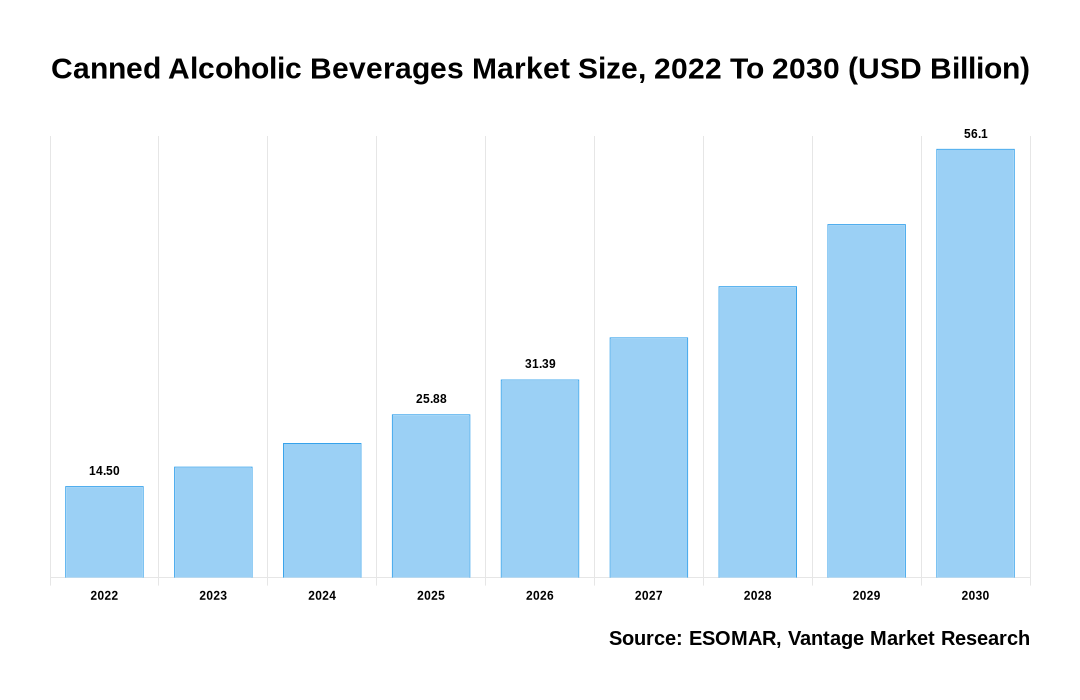Global Canned Alcoholic Beverages Market
As stated in our extensive report; the Global Canned Alcoholic Beverages Market accounted for USD 14.5 Billion in 2022 and is projected to reach a value of USD 56.1 Billion by 2030.
Alcoholic beverages have been consumed by humans for thousands of years, with various forms and flavors evolving over time. In recent years, there has been a significant shift in consumer preferences towards convenience and portability, leading to the growth of the Canned Alcoholic Beverages market. Canned alcoholic beverages offer several advantages over traditional glass bottles, including ease of transportation, lower packaging costs, and reduced risk of breakage.
One of the key trends driving the growth of the Canned Alcoholic Beverages market is the rising demand for convenience. Consumers today lead busy lifestyles and are constantly seeking products that offer convenience without compromising on quality. Canned alcoholic beverages provide a portable and easy-to-consume option, making them popular among consumers. They are lightweight, easy to pack, and can be enjoyed on various occasions such as picnics, beach trips, and outdoor events.
Click To Get a Free Sample On the Research Study

Furthermore, the COVID-19 pandemic has had a positive impact on the Canned Alcoholic Beverages market. With lockdowns and restrictions on dining out, consumers have shifted towards at-home consumption. Canned alcoholic beverages provide a convenient solution for consumers who want to enjoy a drink at home without the need for complex cocktail preparation or purchasing a large bottle of alcohol. The pandemic has also accelerated the e-commerce trend, with consumers increasingly turning to online platforms to purchase their favorite beverages, further driving the growth of the market.
Key factors influencing Canned Alcoholic Beverages Market Growth
The growth of the global Canned Alcoholic Beverages market can be attributable to the following:
- One of the major driving factors behind the growth of Canned Alcoholic Beverages is the convenience they offer to consumers. Cans are easy to carry, lightweight, and the perfect option for on-the-go consumption, such as at concerts, festivals, or outdoor events.
- Millennial and Gen Z consumers, who value convenience and innovation, have played a crucial role in the growth of Canned Alcoholic Beverages. This demographic seeks new and exciting alternatives to traditional alcoholic beverages.
- Another significant driver of the growth is the increasing health consciousness among consumers. Traditional beers and spirits are often high in calories and sugar content, which has led to a rise in demand for low-calorie alternatives. Canned alcoholic beverages, especially hard seltzers, have gained popularity due to their low-calorie content.
- The Canned Alcoholic Beverages market has seen remarkable innovation and variety, extending far beyond traditional beers and spirits. Hard seltzers, for instance, have become a significant segment within the market. These products offer various flavors, including tropical fruits, berries, and citrus, catering to a wide range of tastes.
- Effective branding and marketing strategies have played a pivotal role in the growth of the Canned Alcoholic Beverages market. Many brands have adopted vibrant, eye-catching packaging designs and slogans, targeting the younger consumer demographic.
North America Region to Lead the Market
North America has witnessed maximum growth of the Canned Alcoholic Beverages market in 2022. This rise can be attributed to several factors, including convenience, changing consumer preferences, and the increasing prevalence of time-constrained lifestyles. Consumer preferences have evolved rapidly in recent years, with a growing focus on healthier options with lower sugar content. Canned alcoholic beverages have tapped into this trend by offering a wide range of healthier and low-calorie options. Canned cocktails, hard seltzers, and spritzers have become increasingly popular among health-conscious consumers, as they typically contain fewer calories and sugar compared to traditional alcoholic beverages. This shift in consumer preference has significantly contributed to the growth of the Canned Alcoholic Beverages market in this region.
Europe is another significant market for Canned Alcoholic Beverages, driven by the increasing preference for convenient and portable options. The region has a strong beer-drinking culture, and canned beers are particularly popular among consumers. Additionally, the demand for wine and cocktail-based canned beverages is also rising in Europe.
Conclusion
The growth of the Canned Alcoholic Beverages market can be attributed to various factors, including convenience, changing consumer preferences, health consciousness, innovation, and effective branding and marketing strategies. While the industry faces challenges related to competition, regulation, and sustainability, the market is expected to continue its upward trajectory. The demand for Canned Alcoholic Beverages is projected to increase as consumers seek convenient, portable, and diverse options in the alcoholic beverage market.
Some of the key players in the Global Canned Alcoholic Beverages Market include- Bacardi Limited (U.S.), Diageo (UK), Brown-Forman Corporation (U.S.), Anheuser-Busch InBev (Belgium), Treasury Wine Estates (Australia), Union Wine Company (U.S.), E. & J. Gallo Winery (U.S.), Asahi Group Holdings Ltd. (Japan), Pernod Ricard (France) and others.
![[Market Research Reports] – Research Google News Blog | VMR.Biz](https://www.vmr.biz/wp-content/uploads/2022/12/logo-removebg-preview.png)











